1993 BUICK PARK AVENUE headlights
[x] Cancel search: headlightsPage 94 of 340
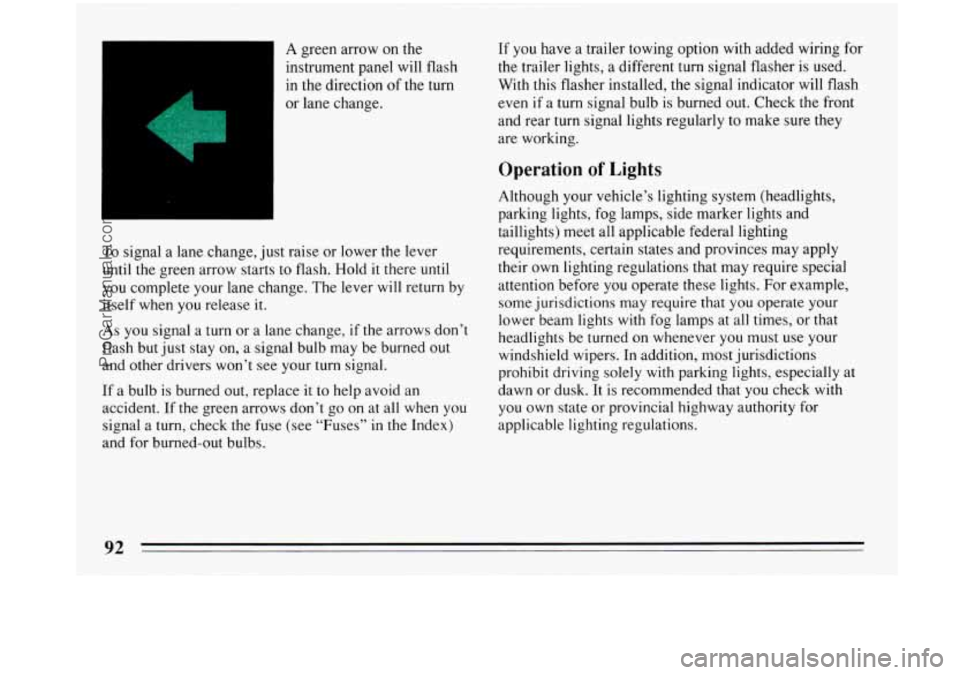
A green arrow on the
instrument panel
will flash
in the direction of the turn
or lane change.
To signal a lane change, just raise or lower the lever
until
the green arrow starts to flash. Hold it there until
you complete your lane change. The lever will return by
itself when you release it.
As you signal a turn or a lane change, if the arrows don’t
flash but just stay on, a signal bulb may be burned out
and other drivers won’t see your turn signal.
If a bulb is burned out, replace it to help avoid an
accident. If
the green arrows don’t go on at all when you
signal a turn, check the fuse (see “Fuses”
in the Index)
and for burned-out bulbs.
If you have a trailer towing option with added wiring for
the trailer lights, a different turn signal flasher is used.
With this flasher installed, the signal indicator will flash
even
if a turn signal bulb is burned out. Check the front
and rear turn signal lights regularly to make sure they
are working.
Operation of Lights
Although your vehicle’s lighting system (headlights,
parking lights, fog lamps, side marker lights and
taillights) meet all applicable federal lighting
requirements, certain states and provinces may apply
their own lighting regulations that may require special
attention before
you operate these lights. For example,
some jurisdictions may require that you operate your
lower beam lights with fog lamps at all times, or that
headlights be turned on whenever you must use your
windshield wipers. In addition, most jurisdictions
prohibit driving solely with parking lights, especially at
dawn or dusk. It is recommended that
you check with
you own state or provincial highway authority for
applicable lighting regulations.
ProCarManuals.com
Page 95 of 340
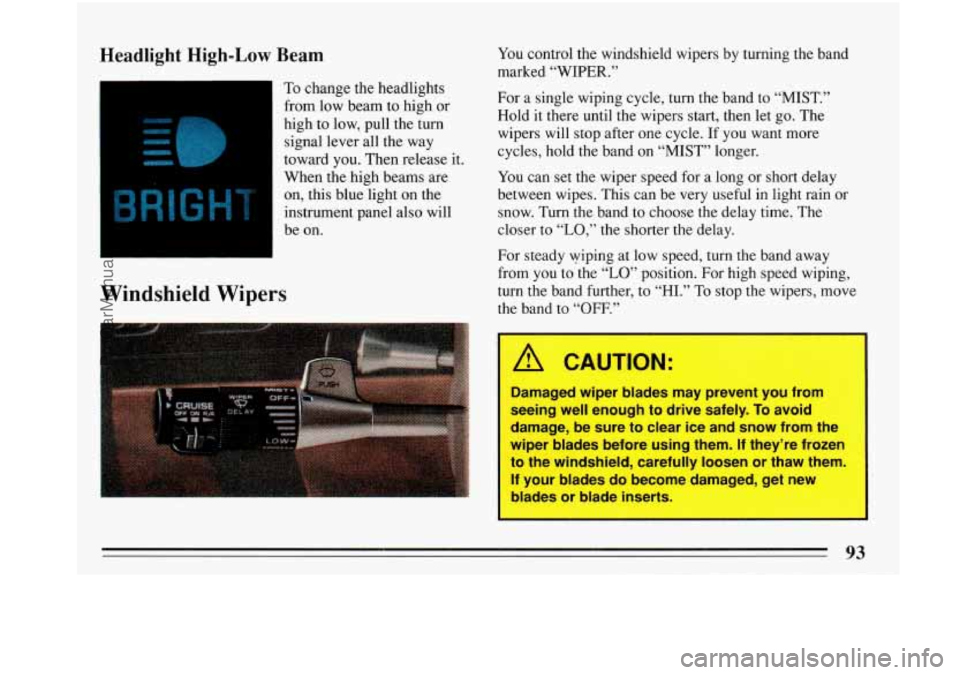
Headlight High-Low Beam
To change the headlights
from low beam to high or
high to low, pull the turn
signal lever. all the way
toward you. Then release it.
When the high beams are
on, this blue light on the
instrument panel also will
be on.
R 1J H
Windshield Wipers
You control the windshield wipers by turning the band
marked
“WIPER.”
For a single wiping cycle, turn the band to “MIST.”
Hold it there until the wipers start, then let go. The
wipers will stop after one cycle. If you want more
cycles, hold the band on “MIST” longer.
You can set the wiper speed for a long or short delay
between wipes. This can be very useful in light rain or
snow. Turn the band to choose the delay time. The
closer to
“LO,” the shorter the delay.
For steady wiping at low speed, turn the band away
from you to the
“LO” position. For high speed wiping,
turn the band further, to “HI.”
To stop the wipers, move
the band to
“OFF.”
A CAUTION:
Damaged wiper blades may prevent you from
seeing well enough to drive safely.
To avoid
damage, be sure to clear ice and snow from the
wiper blades before using them.
If they’re frozen
to the windshield, carefully loosen or thaw them.
If your blades do become damaged, get new
blades or blade inserts.
93
ProCarManuals.com
Page 103 of 340
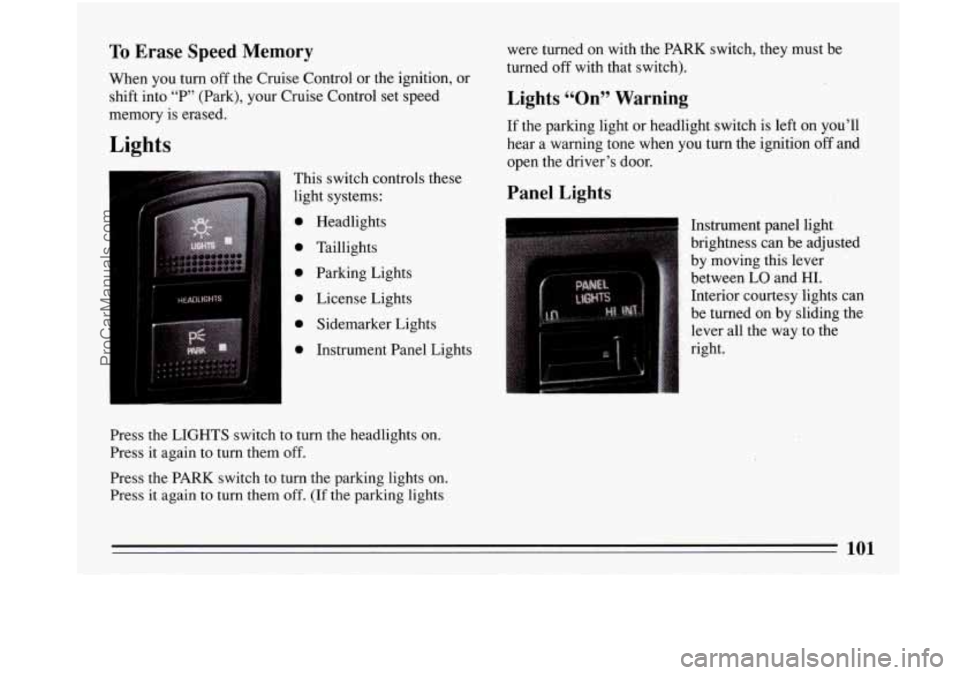
I
I
To Erase Speed Memory
When you turn off the Cruise Control or the ignition, or
shift into
“P” (Park), your Cruise Control ,set speed
memory is erased.
Lights
This switch controls these
light systems:
0 Headlights
0 Taillights
0 Parking Lights
0 License Lights
0 Sidemarker Lights
0 Instrument Panel Lights
Press the LIGHTS switch’to turn the headlights on.
Press it again to turn them
off.
Press the PARK switch to turn the parking lights on.
Press it again
to turn them off. (If the parking lights were turned
on with the PARK switch, they must be
turned
off with that switch).
Lights CCOn” Warning
If the parking light or headlight switch is left on you’ll
hear
a warning tone when you turn the ignition off and.
open the driver’s door.
Panel Lights
Instrument panel light
brightness can be adjusted
by moving this lever
between LO and HI.
Interior courtesy lights can
be turned on by sliding the
.lever all the way to the
right.
101
ProCarManuals.com
Page 105 of 340
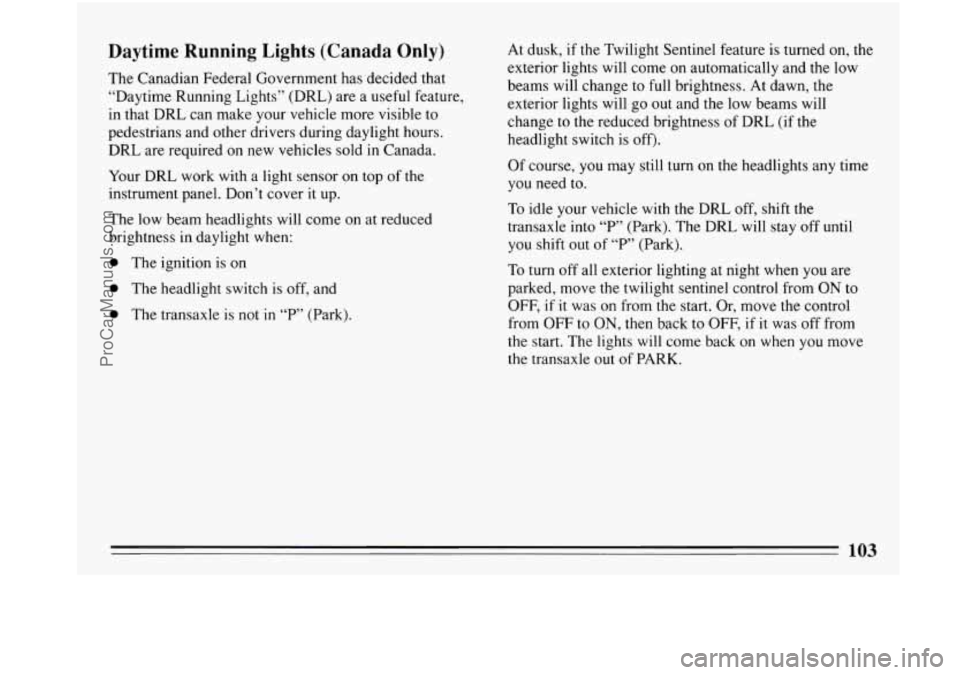
Daytime Running Lights (Canada Only)
The Canadian Federal Government has decided that
“Daytime Running Lights” (DRL) are a useful feature,
in that DRL can make your vehicle more visible to
pedestrians and other drivers during daylight hours.
DRL are required on new vehicles sold in Canada.
Your
DRL work with a light sensor on top of the
instrument panel. Don’t cover it up.
The low beam headlights will come on at reduced
brightness in daylight when:
0 The ignition is on
0 The headlight switch is off, and
0 The transaxle is not in “P” (Park). At
dusk, if the Twilight Sentinel feature is turned on, the
exterior lights will come
on automatically and the low
beams will change to
full brightness. At dawn, the
exterior lights will go out and the low beams will
change to the reduced brightness
of DRL (if the
headlight switch is off).
Of course, you may still turn on the headlights any time
you need to.
To idle your vehicle with the DRL off, shift the
transaxle into
“P” (Park). The DRL will stay off until
you shift out of “P” (Park).
To turn
off all exterior lighting at night when you are
parked, move
the twilight sentinel control from ON to
OFF, if it was on from the start. Or, move the control
from OFF to
ON, then back to OFF, if it was off from
the start. The lights will come back
on when you move
the transaxle out
of PARK.
ProCarManuals.com
Page 108 of 340
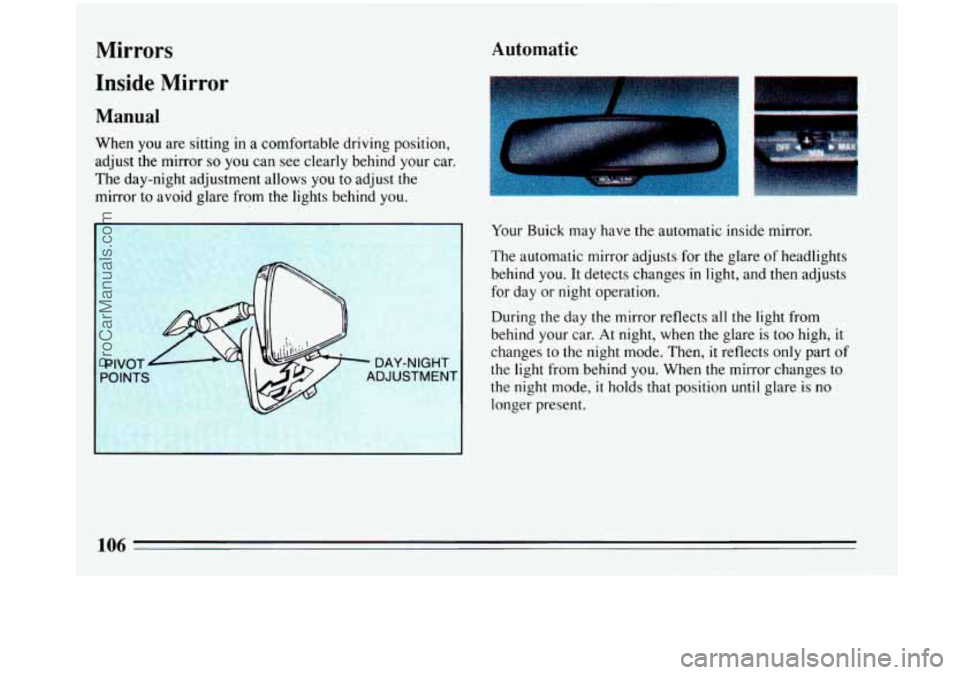
Mirrors
Inside Mirror
Manual
When you are sitting in a comfortable driving position,
adjust the mirror
so you can see clearly behind your car.
The day-night adjustment allows you to adjust
the
mirror to avoid glare from the lights behind you.
PI\,
Polr --!
1
I
7'- DAY-NIGHT
ADJUSTMENT
Automatic
Your Buick may have the automatic inside mirror.
The automatic mirror adjusts for the glare of headlights
behind you. It detects changes in light, and then adjusts
for day or night operation.
During the day the mirror reflects all the light from
behind your car. At night, when the glare
is too high, it
changes to the night mode. Then, it reflects only part of
the light from behind you. When the mirror changes to
the night mode,
it holds that position until glare is no
longer present.
ProCarManuals.com
Page 109 of 340
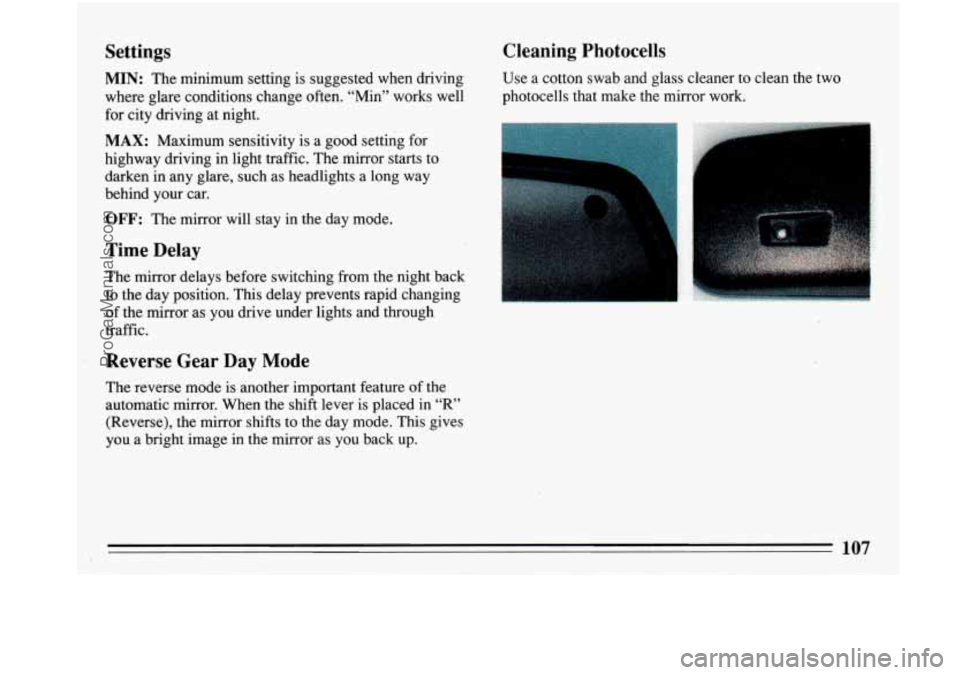
Settings
MIN: The minimum setting is suggested when driving
where glare conditions change often. “Min” works well
for city driving at night.
MAX: Maximum sensitivity is a good setting for
highway driving in light traffic. The mirror starts to
darken in any glare, such as headlights a long way
behind your
car.
OFF: The mirror will stay in the day mode.
Time Delay
The mirror delays before switching from the night back
to the day position. This delay prevents rapid changing
of the mirror as you drive under lights and through
traffic.
Cleaning Photocells
Use a cotton swab and glass cleaner to clean the two
photocells that make the mirror work.
Reverse Gear Day Mode
The reverse mode is another important feature of the
automatic mirror. .When the shift lever is placed in
“R”
(Reverse), the mirror shifts to the day mode. This gives
you a bright image in the mirror as you back up.
107
ProCarManuals.com
Page 183 of 340
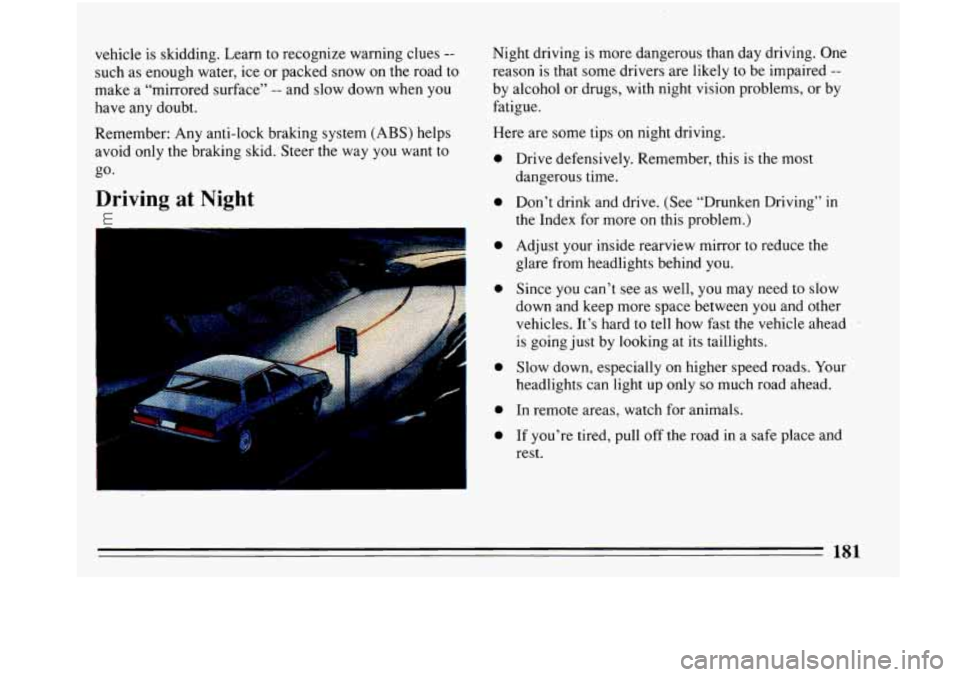
vehicle is skidding. Learn to recognize warning clues --
such as enough water, ice or packed snow on the road to
make a “mirrored surface”
-- and slow down when you
have any doubt.
Remember: Any anti-lock braking system (ABS) helps
avoid only the braking skid. Steer the way
you want to
go-
Driving at Night
...,.
.. -
Night driving is more dangerous than day driving. One
reason
is that some drivers are likely to be impaired --
by alcohol or drugs, with night vision problems, or by
fatigue.
Here are some tips on night driving.
0
0
0
c
0
0
0
Drive defensively. Remember, this is the most
dangerous time.
Don’t drink and drive. (See “Drunken Driving” in
the Index for more on this problem.)
Adjust your inside rearview mirror to reduce the
glare from headlights behind you.
Since you can’t see as well, you may need to slow
down and keep more space between you and other
vehicles. It’s hard
to tell how fast the vehicle ahead .
is going just by looking at its taillights.
Slow down, especially on higher speed roads. Your
headlights can light up only
so much road ahead.
In remote areas, watch for animals.
If you’re tired, pull off the road in a safe place and
rest.
ProCarManuals.com
Page 184 of 340
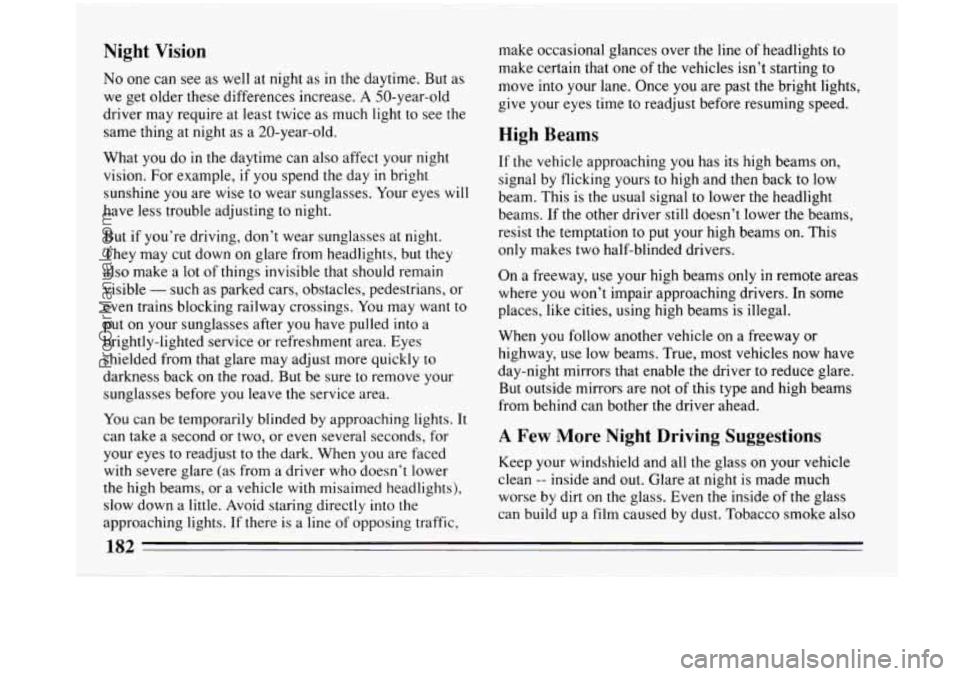
Night Vision
No one can see as well at night as in the daytime. But as
we get older these differences increase. A 50-year-old
driver may require at least twice as much light to see the
same thing at night as a 20-year-old.
What you do in the daytime can also affect your night
vision. For example,
if you spend the day in bright
sunshine
you are wise to wear sunglasses. Your eyes will
have less trouble adjusting to night.
But if you’re driving, don’t wear sunglasses at night.
They may cut down
on glare from headlights, but they
also make a lot of things invisible that should remain
visible
- such as parked cars, obstacles, pedestrians, or
even trains blocking railway crossings. You may want to
put on your sunglasses after you have pulled into a
brightly-lighted service
or refreshment area. Eyes
shielded from that glare may adjust more quickly to
darkness back
on the road. But be sure to remove your
sunglasses before you leave the service area.
You can be temporarily blinded by approaching lights. It
can take
a second or two, or even several seconds, for
your eyes to readjust
to the dark. When you are faced
with severe glare (as from a driver who doesn’t lower
the high beams, or a vehicle with misaimed headlights),
slow down a little. Avoid staring directly into the
approaching lights. If there is a line of opposing traffic, make occasional glances over
the line of headlights to
make certain that one
of the vehicles isn’t starting to
move into your lane. Once
you are past the bright lights,
give your eyes time to readjust before resuming speed.
High Beams
If the vehicle approaching you has its high beams on,
signal by flicking yours to high and then back to low
beam. This is the usual signal to lower the headlight
beams. If the other driver still doesn’t lower the beams,
resist the temptation to put your high beams
on. This
only makes two half-blinded drivers.
On a freeway, use your high beams
only in remote areas
where you won’t impair approaching drivers. In some
places, like cities, using high beams is illegal.
When you follow another vehicle on a freeway or
highway, use low beams. True, most vehicles now have
day-night mirrors that enable the driver to reduce glare.
But outside mirrors are not of this type and high beams
from behind can bother the driver ahead.
A Few More Night Driving Suggestions
Keep your windshield and all the glass on your vehicle
clean
-- inside and out. Glare at night is made much
worse by dirt on the glass. Even the inside of the glass
can build up a film caused by dust. Tobacco smoke also
ProCarManuals.com